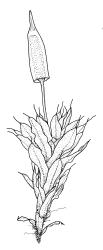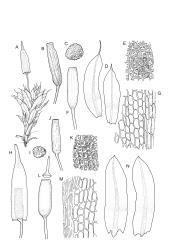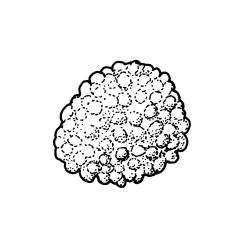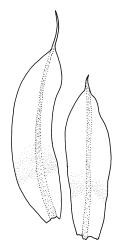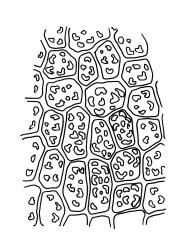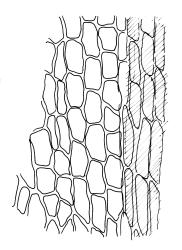Plants dull, red-brown. Stems to c. 8 mm in N.Z. material, mostly branched. Leaves oblong-lanceolate, rather abruptly narrowed above to an acute apex, with a short or long hair-point, mostly spiralled around the stem when dry, not markedly inrolled, erect-spreading when moist, entire, in cross-section U-shaped or weakly-keeled and with margins plane, 2.0–3.5 × 1 mm; upper laminal cells short-oblong or subquadrate, bulging, each with several (mostly 4–6) c-shaped papillae, mostly 12–21 × 12–15 µm, becoming ± oblate in a few rows near the margins, grading into the cells of the lower lamina; cells of lower lamina elongate-oblong, smooth, with thin longitudinal walls and strongly thickened, yellow-orange transverse walls (especially near base of costa); cells of the lower margin lacking thickened transverse walls, forming a border 5–6 cells wide that fades at the junction with the papillose laminal cells. Costa stout and prominent abaxially, red-brown or less commonly yellow-brown, mostly short- to long-excurrent (rarely percurrent) to form a concolourous or apically pale hair-point, lustrous when dry, smooth abaxially, in cross-section with 1–2 layers of guide cells, 1 layer of papillose adaxial cells (not differing from adjacent laminal cells), and a large abaxial stereid band.
Gonioautoicous. Perichaetia with leaves scarcely differentiated, often overtopped by innovations. Perigonia located immediately below perichaetia. Setae 3–5 mm, red-brown or orange, smooth, straight, not twisted; capsules as per genus, longitudinally furrowed when dry, gold-brown, red at mouth, 2.5–3.2 mm; exothecial cells mostly elongate-oblong, in alternating bands of thick- and thinner-walled cells; stomata superficial, apparently scattered in lower urn (occurring to c. ⅓ above base); annulus lacking; operculum narrowly long-rostrate from a conic base, straight, c. 1.5 mm, often falling with the calyptra. Peristome nil in N.Z. material. Spores reniform, coarsely bullate-insulate on distal surface, with individual insulae 5–6 µm across, proximal surface indistinctly trilete, c. 38 µm diam. Calyptra narrowly long-mitrate, completely enclosing the capsule, not lobed at base, weakly scabrous near tip, c. 5 mm long.
Horton 1983, figs. 171–177; Horton 1994, fig. 314; Ochyra et al. 2008, fig. 45; Smith 2004, fig. 162, 11–14.
Apart from pottiaceous taxa mentioned in the generic discussion, confusion is likely only with the more common E. vulgaris, which can be segregated by the features in the key.
NI: Wellington (Ruahine Range); SI: Nelson (Arthur Range, Owen Range), Canterbury (Broken River), Southland (Takahē Valley); Ch (Pitt I.). The sole collection from the "northwestern Ruahine Ra." is a poorly documented one made by A.P. Druce in 1948.
Bipolar. Widespread in North America, northern Europe and parts of Asia (Horton 1983). Smith (2004) and Hoe (1974) recorded it from Hawaii. Ochyra et al. (2008) recorded it from Patagonia, the Antarctica Peninsula, and the South Orkney Is.
Occurring mostly in cracks in massive limestone and marble outcrops and boulders and on derived soil detritus. In the Takahē Valley it is a common species for more than 200 m along the base of a limestone bluff at the eastern end of Lake Orbell. The Pitt I. (Hākepa Hill) collection (P. de Lange & P.B. Heenan CH2246, CHR 604653) was growing "threaded through Lolium perenne and Hymenophyllum multifidum" on soil derived from trachyte (a feldspar-rich intrusive rock often associated with basalt). At Hākepa Hill the trachyte has weathered to form "pseudo-karst" topography that included well-developed dolines and blind valleys. Encalypta rhaptocarpa is frequently associated with Brachythecium paradoxum, Bryoerythrophyllum recurvirostrum, Camptochaete aciphylla, Distichium capillaceum, Encalypta vulgaris, Lepyrodon australis, L. lagurus, Philonotis scabrifolia, Plagiobryum novae-seelandiae, and Syntrichia serrata. On SI ranging from c. 790 (Takahē Valley) to at least 1800 m (Mt Owen) elevation. The Pitt I. collection was from c. 220 m.



